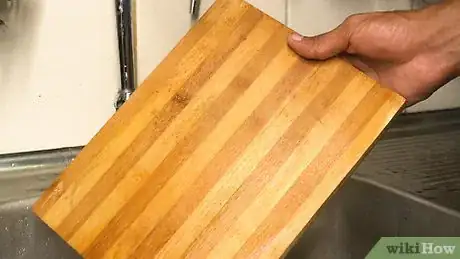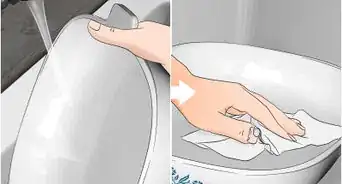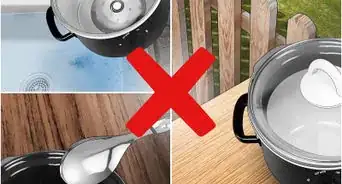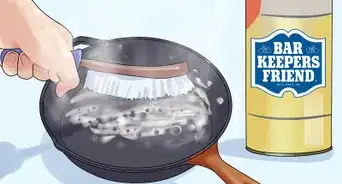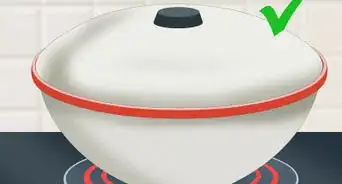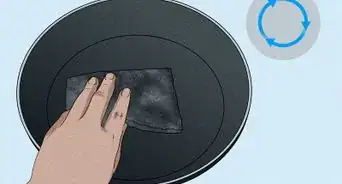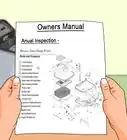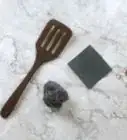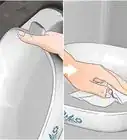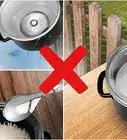This article was co-authored by Raymond Chiu. Raymond Chiu is the Director of Operations for MaidSailors.com, a residential and commercial cleaning service based in New York City that provides home and office cleaning services at affordable prices. He has a Bachelors in Business Administration and Management from Baruch College.
This article has been viewed 79,523 times.
A bamboo cutting board is stronger, more durable, and more hygienic than a wooden cutting board. They also look great and are a more sustainable material than wood.[1] They do, however, require special care and maintenance in order to prevent them from being damaged. You will need to wash your bamboo cutting board quickly and carefully so that it does not warp or crack. If your bamboo cutting board gets stained or starts to smell, there are easy, natural ways to restore it. To keep your bamboo cutting board in prime condition, you will also need to coat it in mineral oil occasionally.
Steps
Washing a Bamboo Cutting Board
-
1Wash the cutting board in warm water and soap quickly. Wash your bamboo cutting board immediately after use, and do not wash it for more than a few minutes. You should also prevent hot water from coming into contact with bamboo because it can damage it.[2]
- Do not use an abrasive material to scrub your bamboo cutting board. Rub the board with your hands or a soft cloth if you need to remove larger pieces of food.
-
2Avoid soaking your cutting board in water. Bamboo is sensitive to heat and moisture, especially over prolonged periods. Do not put your bamboo cutting board in the dishwasher or let it soak in the sink, or it will warp and develop cracks.Advertisement
-
3Rinse your bamboo cutting board with lukewarm water. Make sure to get all of the soap and food residue off of the cutting board by holding it under the running water. Even though the water is not hot, you want to limit the board’s exposure to water, so rinse as quickly as you can.[3]
-
4Dry your bamboo cutting board immediately. As soon as your board is rinsed, dry it off with a soft towel. After you have dried it with a towel, stand it up vertically and allow it to air dry.[4]
- Air drying the board can take a few hours.
Removing Stains and Odors
-
1Sprinkle coarse sea salt on the surface of the cutting board. Ideally, you should do this immediately after you have washed and rinsed your cutting board, but before it has been dried. Apply extra salt to any stained areas. The salt will act as an abrasive material for scrubbing and it will soak up excess moisture.[5]
- If you are dealing with a particularly stubborn stain, apply some baking soda instead.[6]
-
2Scrub the board with a halved lemon. Lemon juice will kill bacteria and remove odors from the bamboo. Hold the citrus side of the lemon against the board. Press it into the salt and move it back and forth in a scrubbing motion until the salt has disappeared.[7]
- Make sure you also scrub the corners and edges of your board.
-
3Cover the surface of your cutting board with another layer of salt. Spread the salt out evenly. Do not scrub off this second layer of salt.
- Your cutting board should still be somewhat wet from the lemon juice when you apply this second layer of salt. Do not dry the lemon juice off of your cutting board.
-
4Leave the salt on the cutting board over night. If you cannot leave it out over an entire night, you should let the salt stay on the board for at least 2 hours.[8] The lemon juice needs time to penetrate the wood, and the salt will then soak up the excess moisture.
-
5Remove the salt from the bamboo cutting board. Use the back of a spatula to scrape off the salt. Take a damp clean cloth and wipe off any remaining residue.[9]
- You can reuse this salt until it is no longer white. Just scrape it into a container and store it.
Performing Regular Maintenance
-
1Heat up some mineral oil until it is warm. Pour the mineral oil into a small pan and heat it on the stove until it is warm to the touch. You do not want it to be hot, just warm enough so that the oil soaks into the bamboo.[10]
- Only use food grade mineral oil on your bamboo cutting board.
-
2Drizzle the warm oil onto all surfaces of the cutting board. Only do one of the large flat sides at a time so that the oil will spread more evenly. Don’t forget to oil the corners and edges.
- The oil will create a protective barrier that keeps enough moisture in the board to prevent cracking from dryness, but keeps enough water out to prevent warping.
-
3Work in the oil using a soft cloth. Spread the oil around the board using the cloth to get an even coat. Rub with the grain if your bamboo cutting board’s grain has a uniform direction. If it doesn’t, buff in the oil using a small circular motion.[11]
- Once the oil has soaked into one side of the board, repeat the process with the other side and the edges.
-
4Let the oil soak into the bamboo for at least 1 hour. If you are able, you may let the oil soak into the bamboo overnight. Position the board upright on one of its edges while you let the oil soak in.[12]
- After the board has soaked, wipe off any excess oil with a clean cloth.
- Make sure that you set the oil-soaked board on a surface that will not be damaged by oil stains. Putting it on a plate or an air-dry dish rack would be ideal.
-
5Store the cutting board in a cool, dry place. Prolonged exposure to heat, moisture, and even direct sunlight can cause damage to a bamboo cutting board. Try not to store it with objects that might scratch it like sharp knives and metal utensils.[13]
- You should only need to oil your cutting board 1 or 2 times a month. Some people prefer to treat their cutting boards with oil after every use. This can be time consuming, but it does offer more protection for your cutting board.
Expert Q&A
Did you know you can get expert answers for this article?
Unlock expert answers by supporting wikiHow
-
QuestionHow do I sanitize my wood cutting board?
 Raymond ChiuRaymond Chiu is the Director of Operations for MaidSailors.com, a residential and commercial cleaning service based in New York City that provides home and office cleaning services at affordable prices. He has a Bachelors in Business Administration and Management from Baruch College.
Raymond ChiuRaymond Chiu is the Director of Operations for MaidSailors.com, a residential and commercial cleaning service based in New York City that provides home and office cleaning services at affordable prices. He has a Bachelors in Business Administration and Management from Baruch College.
House Cleaning Professional
-
QuestionIs it safe to use hot water on a cutting board?
 Raymond ChiuRaymond Chiu is the Director of Operations for MaidSailors.com, a residential and commercial cleaning service based in New York City that provides home and office cleaning services at affordable prices. He has a Bachelors in Business Administration and Management from Baruch College.
Raymond ChiuRaymond Chiu is the Director of Operations for MaidSailors.com, a residential and commercial cleaning service based in New York City that provides home and office cleaning services at affordable prices. He has a Bachelors in Business Administration and Management from Baruch College.
House Cleaning Professional
References
- ↑ https://www.campchef.com/blog/how-to-care-for-bamboo-cutting-board.html
- ↑ Raymond Chiu. House Cleaning Professional. Expert Interview. 15 October 2019.
- ↑ https://www.campchef.com/blog/how-to-care-for-bamboo-cutting-board.html
- ↑ Raymond Chiu. House Cleaning Professional. Expert Interview. 15 October 2019.
- ↑ Raymond Chiu. House Cleaning Professional. Expert Interview. 15 October 2019.
- ↑ https://healthy-cookware.com/cleaning-and-maintenance-of-bamboo-cutting-boards/
- ↑ Raymond Chiu. House Cleaning Professional. Expert Interview. 15 October 2019.
- ↑ https://www.mythirtyspot.com/properly-clean-bamboo-cutting-board/
- ↑ https://www.mythirtyspot.com/properly-clean-bamboo-cutting-board/
- ↑ https://healthy-cookware.com/cleaning-and-maintenance-of-bamboo-cutting-boards/
- ↑ https://www.campchef.com/blog/how-to-care-for-bamboo-cutting-board.html
- ↑ https://healthy-cookware.com/cleaning-and-maintenance-of-bamboo-cutting-boards/
- ↑ https://healthy-cookware.com/cleaning-and-maintenance-of-bamboo-cutting-boards/
- ↑ https://healthy-cookware.com/cleaning-and-maintenance-of-bamboo-cutting-boards/

